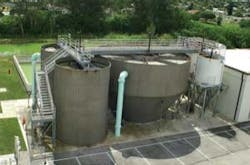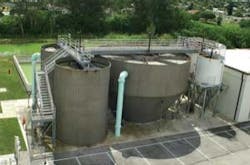Desalination R&D project completed by Siemens, sets new benchmark on low-energy seawater desalination
SINGAPORE, July 5, 2011 -- A Siemens research and development initiative has shown that a new desalination process reduces desalting energy by over 50% compared to best available technology.
The research was conducted at a demonstration plant built in Singapore to treat seawater to drinking water quality. Since December 2010, the Siemens demonstration unit has been treating 50 m³ of seawater per day at a PUB facility in Singapore.
The project goal was to produce World Health Organization standard drinking water quality from seawater, at the same time cutting energy consumption by half compared to current technologies. Instead of using reverse osmosis, which requires high-pressure pumps to force water through semi-permeable membranes, the Siemens engineers turned to electrochemical desalination. The process combines electrodialysis (ED) and continuous electrodeionization (CEDI), both applying an electric field to draw sodium and chloride ions across ion exchange membranes and out of the water. As the water itself does not have to pass through the membranes, the process can be run at low pressure, and hence low power consumption.
The seawater is pre-treated with a self-cleaning disk filter, followed by Memcor ultrafiltration modules. The pilot desalination plant is composed of three ED units arranged in series to handle high concentrations of salt. They are followed by three CEDI units assembled in a parallel flow configuration to remove smaller amounts of salt.
The energy demand of the whole process including pumping, pre-treatment, desalting, and post-treatment is less than half of what is used by the best available seawater desalination technologies today, which is typically between 3.4 and 4.8 kWh/m³. Besides the energy savings, other advantages are low vibration and noise levels, improved safety, and only minimal pre- and post-treatment.
Siemens said it is now poised to transition this new technology to the product development phase. The next step will be to set up a full-scale system in cooperation with Singapore's national water agency PUB by 2013.
###

